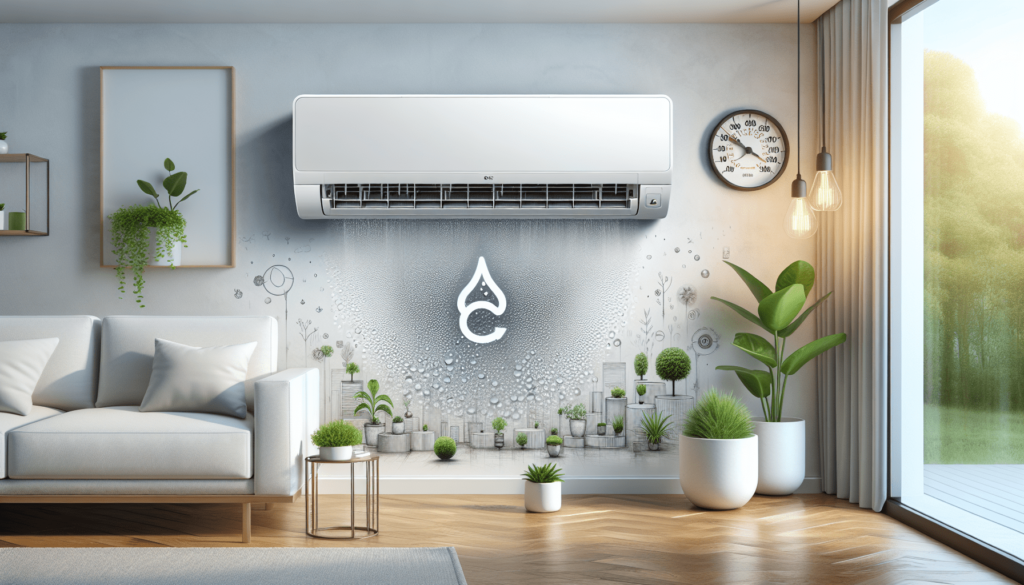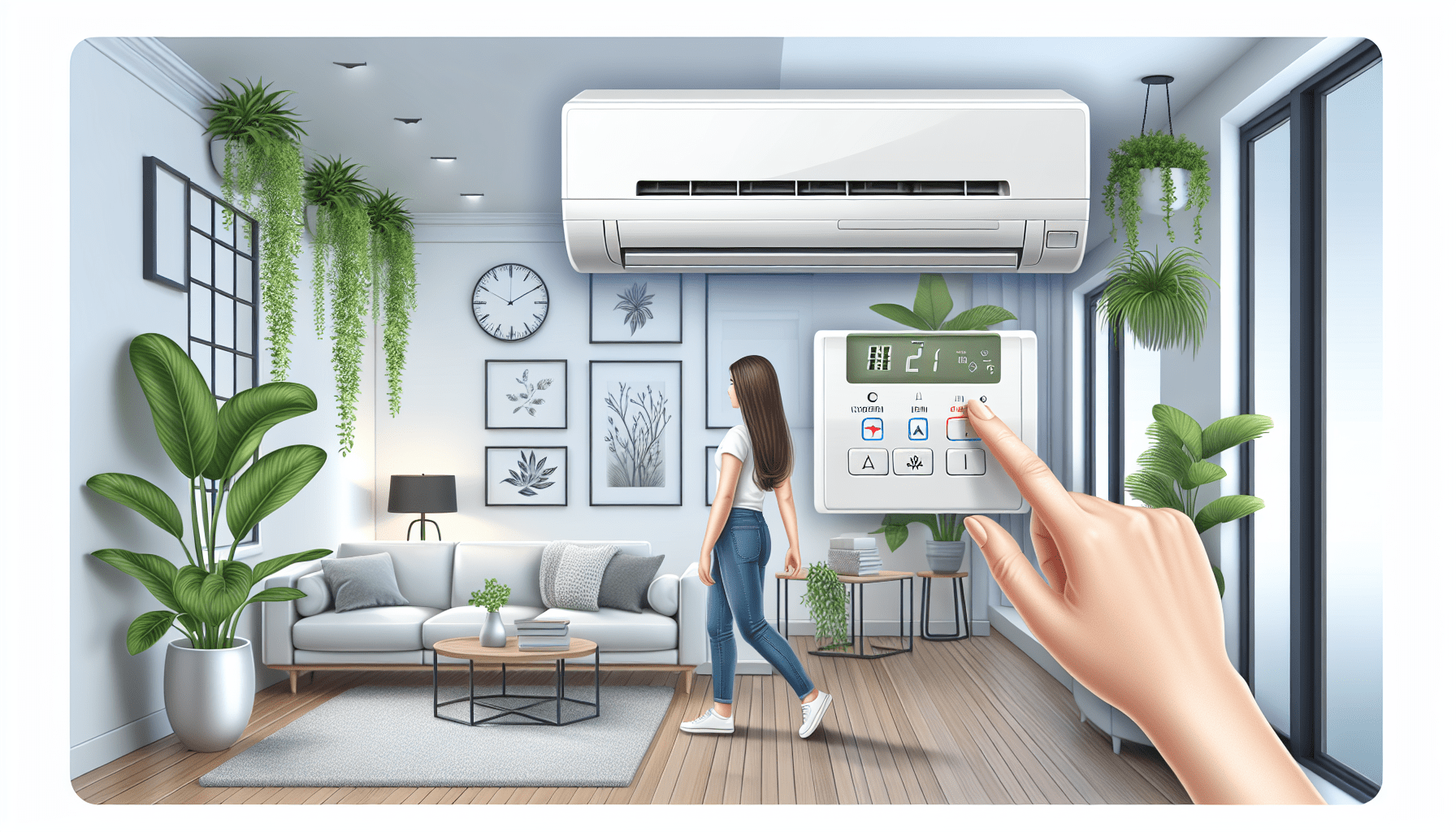In this article, you will discover some valuable tips on how to effectively control humidity using a Mini Split AC. Whether you are dealing with excessive moisture during the summer or struggling with dry indoor air during the winter, these tips will help you create a comfortable and balanced environment in your home. By understanding the importance of humidity control and implementing these practical suggestions, you can enjoy optimal indoor air quality all year round.

Regular Maintenance
Regular maintenance is key to ensuring that your mini split AC operates at its best and effectively controls humidity in your space. Here are some important maintenance tasks to keep in mind:
Clean or replace filters regularly
Filters play a crucial role in removing dust, allergens, and other particles from the air. Over time, these filters can become clogged and hinder the airflow of your AC unit. It is important to clean or replace these filters regularly to maintain optimal performance and prevent humidity issues.
Clean the condenser coils
Condenser coils are responsible for transferring heat from the indoor unit to the outdoor unit. Dust and debris can accumulate on these coils, causing them to function less efficiently. Regularly cleaning the condenser coils ensures proper heat transfer, which ultimately helps in controlling humidity levels.
Check for leaks in the drain line
The drain line is responsible for removing the moisture that accumulates in the indoor unit. Over time, the drain line may develop leaks, which can lead to water pooling and potential humidity issues. Regularly checking for leaks in the drain line and promptly fixing them can prevent moisture buildup and maintain a comfortable humidity level in your space.
Proper Sizing and Placement
For your mini split AC to effectively control humidity, it is essential to consider proper sizing and placement. Here are a few important points to keep in mind:
Choose the right size AC unit for your space
Selecting an AC unit that is too small for your space can lead to inadequate dehumidification. On the other hand, choosing an AC unit that is too large may result in short cycling, where the unit cools the air quickly without properly removing the humidity. Properly sizing your AC unit ensures it can effectively dehumidify your space.
Install the indoor unit at the right height
Installing the indoor unit at the right height is crucial for efficient humidity control. Mount the unit at a height that allows for optimal air circulation and distribution throughout the room. Avoid placing it too high or too low, as it may lead to uneven cooling and humidity levels in the space.
Ensure proper clearance for airflow
To maximize the performance of your mini split AC, it is important to provide adequate clearance for airflow around the units. Avoid obstructing the indoor or outdoor unit with furniture, curtains, or any other objects that may restrict the airflow. Proper clearance allows the AC system to efficiently remove moisture from the air and maintain a comfortable humidity level.
Set the Right Fan Speed
Controlling the fan speed of your mini split AC can significantly impact the humidity levels in your space. Here’s how you can set the fan speed for optimal dehumidification:
Adjust the fan speed to control humidity levels
In areas with high humidity, setting the fan speed to a higher setting can help in moisture removal. The increased airflow enhances the evaporation process, effectively reducing humidity levels in your space. However, keep in mind that higher fan speeds may also result in increased energy consumption.
Use the low fan speed for more dehumidification
In situations where humidity is the main concern, setting the fan speed to low can help promote better dehumidification. The slower fan speed allows the AC unit more time to remove moisture from the air, resulting in lower humidity levels. It is important to find the right balance between energy efficiency and humidity control when considering fan speed settings.
Utilize the Dry Mode
Most mini split AC units come equipped with a dry mode function specifically designed to remove excess moisture from the air. Here’s how you can utilize this feature for better humidity control:
Activate the dry mode function on your mini-split AC
The dry mode function, often represented by a droplet symbol, is specifically designed to dehumidify the air in your space. When activated, the AC unit adjusts its operation to prioritize moisture removal. It runs a cooling cycle to lower the temperature and removes moisture from the air, helping to create a more comfortable indoor environment.
The dry mode helps remove excess moisture from the air
By activating the dry mode, you are allowing your mini split AC to focus on dehumidification rather than solely cooling the space. This feature can be particularly useful during humid seasons or in areas where moisture is a persistent issue. Using the dry mode in combination with other dehumidification techniques can help maintain optimal humidity levels in your home or office.

Ventilate the Space
Improving air circulation in your space is vital for controlling humidity levels. Here are some effective ways to enhance ventilation:
Use a ceiling fan or portable fan to improve air circulation
Ceiling fans or portable fans can help circulate the air in your space, preventing stagnant, humid conditions. Running fans throughout the room creates better air movement, allowing the AC unit to distribute cool, dehumidified air evenly. This can help in reducing both temperature and humidity levels, creating a more comfortable environment.
Open windows or doors for fresh air exchange
Another simple yet effective way to enhance ventilation is by opening windows or doors to let fresh air in. During periods of low humidity or when the outdoor humidity levels are lower than inside, properly timed airflow can help replace stale air and reduce indoor humidity. Just make sure to close them when the outside air becomes humid, as it can cause an increase in humidity levels inside.
Use a Dehumidifier
In especially humid areas or if you are dealing with persistent humidity issues, utilizing a standalone dehumidifier in addition to your mini split AC can provide extra moisture control. Here’s how a dehumidifier can help:
Consider using a standalone dehumidifier in addition to your mini split AC
A dehumidifier is specifically designed to remove excess moisture from the air, making it a valuable asset in controlling humidity levels. By using a dehumidifier in conjunction with your mini split AC, you can enhance the dehumidification process, especially in highly humid regions or during humid seasons.
A dehumidifier can provide extra moisture control in humid areas
If you live in an area with consistently high humidity levels or experience excessive moisture in specific rooms, using a dehumidifier can be highly beneficial. Place the dehumidifier in areas prone to moisture buildup, such as basements, laundry rooms, or bathrooms, to effectively remove excess humidity, preventing the growth of mold and mildew.
Seal Air Leaks
Air leaks can significantly contribute to increased humidity levels in your space. Identifying and sealing these leaks is crucial for effective humidity control. Here’s what you need to do:
Inspect windows, doors, and other areas for air leaks
Start by carefully inspecting windows, doors, and any other areas where air may be leaking into your space. Look for cracks, gaps, or worn-out weatherstripping that may allow humid air from outside to seep in. Identifying these leaks is the first step in preventing excess humidity and maintaining a comfortable indoor environment.
Seal any gaps or cracks to prevent humid air infiltration
Once you have identified the air leaks, it is important to seal them properly. Use caulk or weatherstripping to seal any gaps around windows and doors. Pay close attention to areas around frames and joints where air may be entering. By preventing the infiltration of humid air, you can effectively control humidity levels and improve overall comfort.
Control Heat Sources
Heat-emitting appliances and activities can contribute to increased humidity levels in your space. Taking necessary measures to control these sources of heat can help in managing humidity. Here’s what you can do:
Keep heat-emitting appliances away from the AC unit
Appliances such as ovens, dryers, and stoves emit heat, which can increase humidity levels in your space. It is important to keep these appliances away from the AC unit to prevent the AC from working harder to cool the air and remove the added humidity. Ensure proper spacing and ventilation for such appliances to reduce the impact on humidity control.
Reduce heat from cooking by using exhaust fans
Cooking can release a significant amount of heat and moisture into the air, affecting indoor humidity levels. To minimize the impact of cooking on humidity, use exhaust fans or range hoods to remove the humid air directly from the kitchen. This helps in preventing excess moisture from spreading throughout the rest of the space and aids in better humidity control.
Use Insulation
Proper insulation plays a crucial role in preventing outside humidity from infiltrating your space. Here are a few ways that insulation can help in humidity control:
Proper insulation can help prevent outside humidity from entering your space
Insulation acts as a barrier that prevents outside air, including humid air, from entering your space. Well-insulated walls, floors, and ceilings help maintain a stable indoor environment by reducing the impact of fluctuating outdoor humidity levels. Upgrading or adding insulation can significantly contribute to better humidity control and overall comfort.
Seal gaps and insulate ductwork for better humidity control
In addition to general insulation, it is important to pay attention to sealing gaps and insulating ductwork in your space. Leaky ducts can introduce humid air into your home or office, compromising the effectiveness of your mini split AC’s dehumidification efforts. Properly sealing and insulating ducts helps maintain a consistent humidity level and enhances the overall efficiency of your AC system.
Monitor and Adjust Settings
Monitoring and adjusting temperature and humidity settings as needed is crucial for maintaining optimal comfort in your space. Here’s how you can effectively manage your mini split AC settings:
Monitor and adjust temperature and humidity settings as needed
Keep track of the temperature and humidity levels in your space using a thermostat or hygrometer. You can set the thermostat to a moderate temperature that suits your comfort preferences while balancing energy efficiency. Additionally, monitor the humidity levels and make adjustments accordingly. Most mini split AC units allow for precise temperature and humidity control, enabling you to create a comfortable environment tailored to your needs.
By following these top tips for controlling humidity with a mini split AC, you can create a comfortable, healthy, and humidity-free indoor environment. Regular maintenance, proper sizing and placement, setting the right fan speed, utilizing the dry mode, ventilating the space, using a dehumidifier, sealing air leaks, controlling heat sources, using insulation, and monitoring and adjusting settings all contribute to effective humidity control. Implement these strategies in your space, and enjoy a cool and comfortable environment throughout the year.

